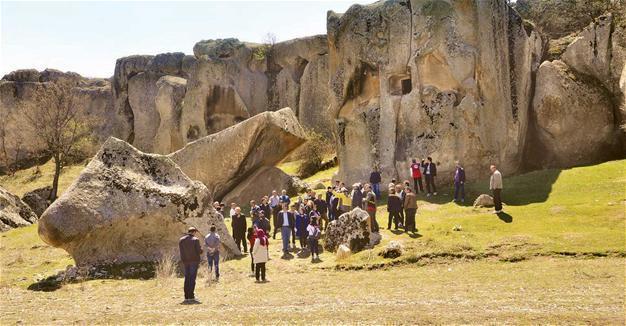Guide shows off riches of hrygian Valley
AFYONKARAHİSAR – Anadolu Agency
 Muzaffer Uyan gave up his day job 15 years ago, but the former culture and tourism director is continuing to pursue his true passion: working as a volunteer guide and taking visitors through the Frig (Phrygian) Valley in western Turkey.
Muzaffer Uyan gave up his day job 15 years ago, but the former culture and tourism director is continuing to pursue his true passion: working as a volunteer guide and taking visitors through the Frig (Phrygian) Valley in western Turkey.“I have learned about the historic and cultural values of Afyonkarahisar from experts,” said Uyan, who has spent the past four decades acting as a guide in the region, which is located at the intersection among Afyonkarahisar, Eskişehir and Kütahya. The valley, which was home to the Phrygian civilization between 900 and 600 B.C., draws tourists to its Cappadocia-like rock formations, rock tombs, churches and caves that were carved for shelter.
“For example, I learned all the fronts of the War of Independence from some colonels. Right now, no one knows the exact places of the real fallen soldiers in the city. I previously published a book named ‘Tınaztepe.’ I took photos of Greek positions on the mountains for three years. I talked to old people in the region and learned many things from them,” he said, noting that he had dedicated his life to promoting the city’s historic and touristic values.
Uyan said he had also examined the flora and fauna of the region with university academics and was part of a team that discovered underground inns in the area.
“Afyonkarahisar has a very unique geological structure. The field of the Phrygian Valley rocks is called ‘galadia volcanites.’ I have examined lots of inns in this area, but there are many we cannot go inside. This field is totally volcanic like Nevşehir and Kayseri,” he said, referring to the Central Anatolian provinces where Cappadocia is located.
Colorful fairy chimneys
Uyan said the Phrygian Valley covered a very large area.
“You cannot finish visiting the valley in five days. We have endemic species here. The Apollo butterfly, which only exists in three places in Turkey, is one of them. The main center of the valley is Yazılıkaya in Eskişehir.
We have a road starting from İscehiar district’s Seydiler neighborhood. The road is 120 kilometers but cars cannot reach some spots, meaning we have to walk. There are many fairy chimneys in this region and some are colorful. I don’t take tours to these places to prevent any damage. We only show people artifacts on the main road.”
He said the Aslantaş, Yılantaş, rock tombs and Maltaş open-air temple were must-see destinations in the valley, adding that he guided at least 30 tours a year.
Uyan said the unique artifacts of the Phrygian civilizations only existed in that region. “This place has a big tourist potential. Right now, Afyonkarahisar is suffering the same troubles that Nevşehir and Ürgüp [in Cappadocia] suffered in the 1980s. The biggest deficiency of the Phrygian Valley is the lack of accommodation here. This is why people visit on a daily basis.”
Uyan said he expected more tourists to come to the valley in the event that transport improved.
















